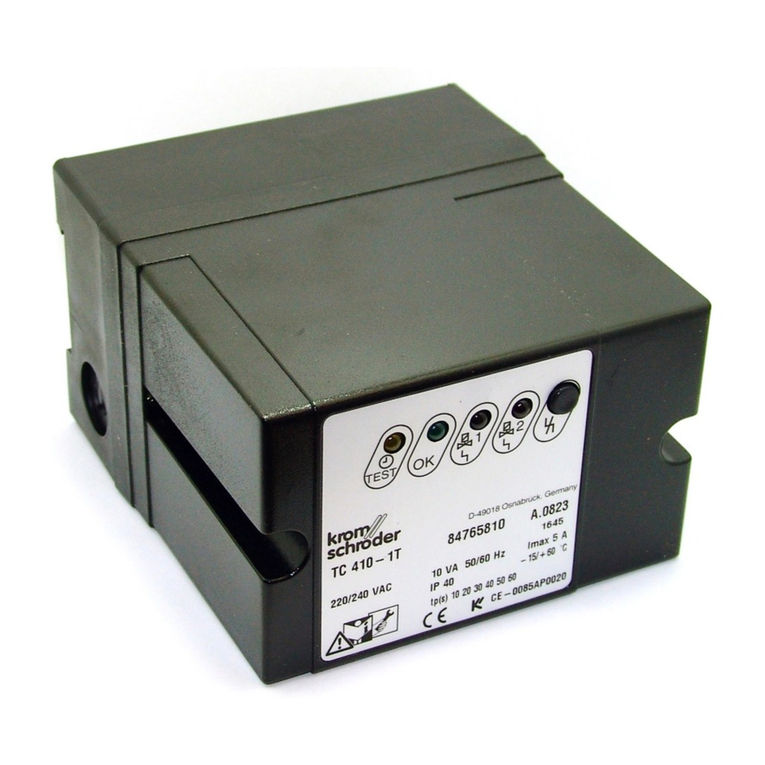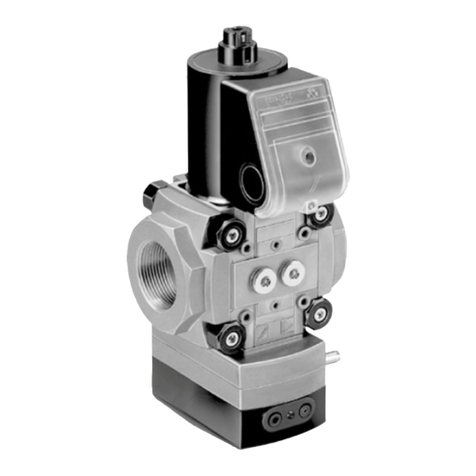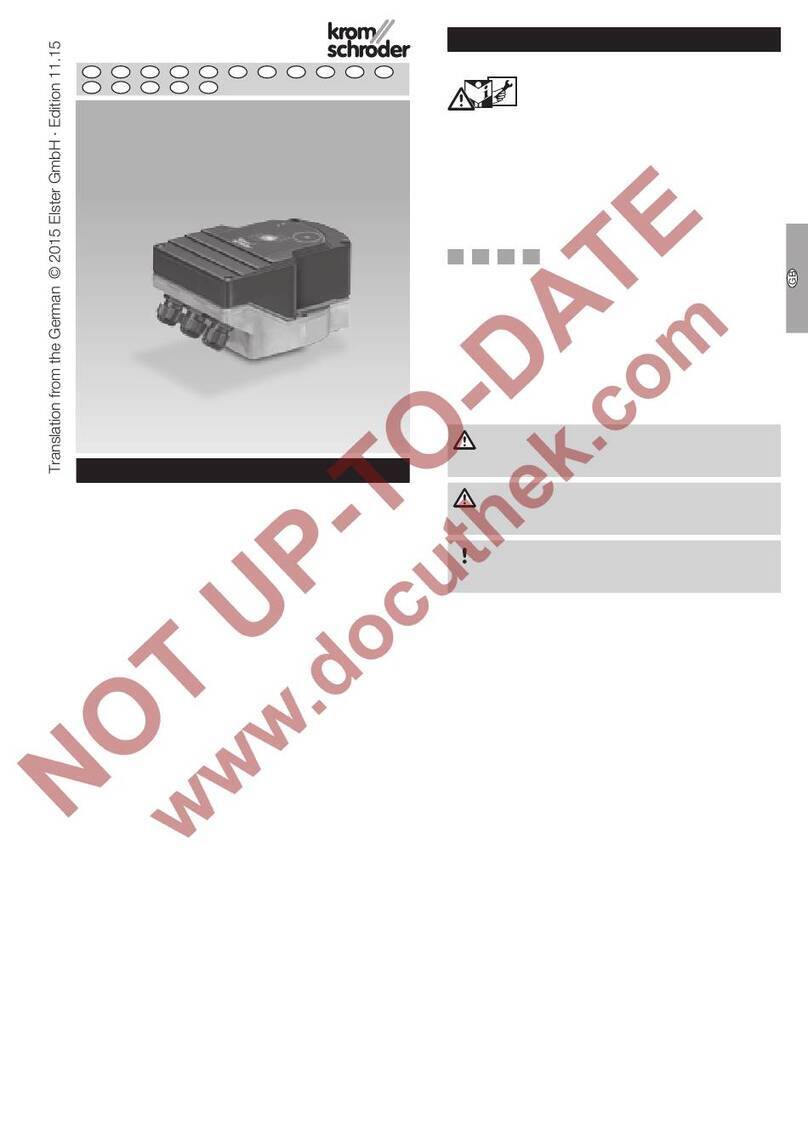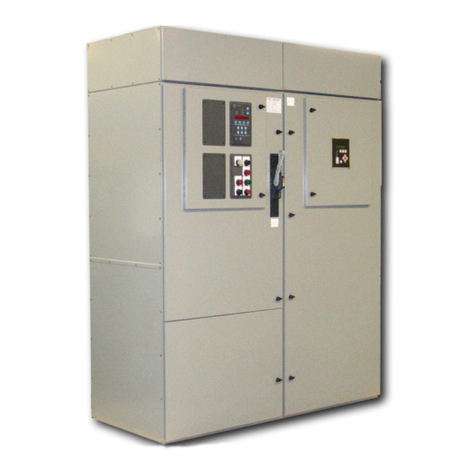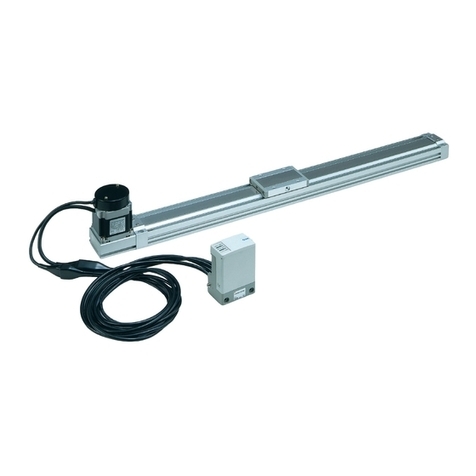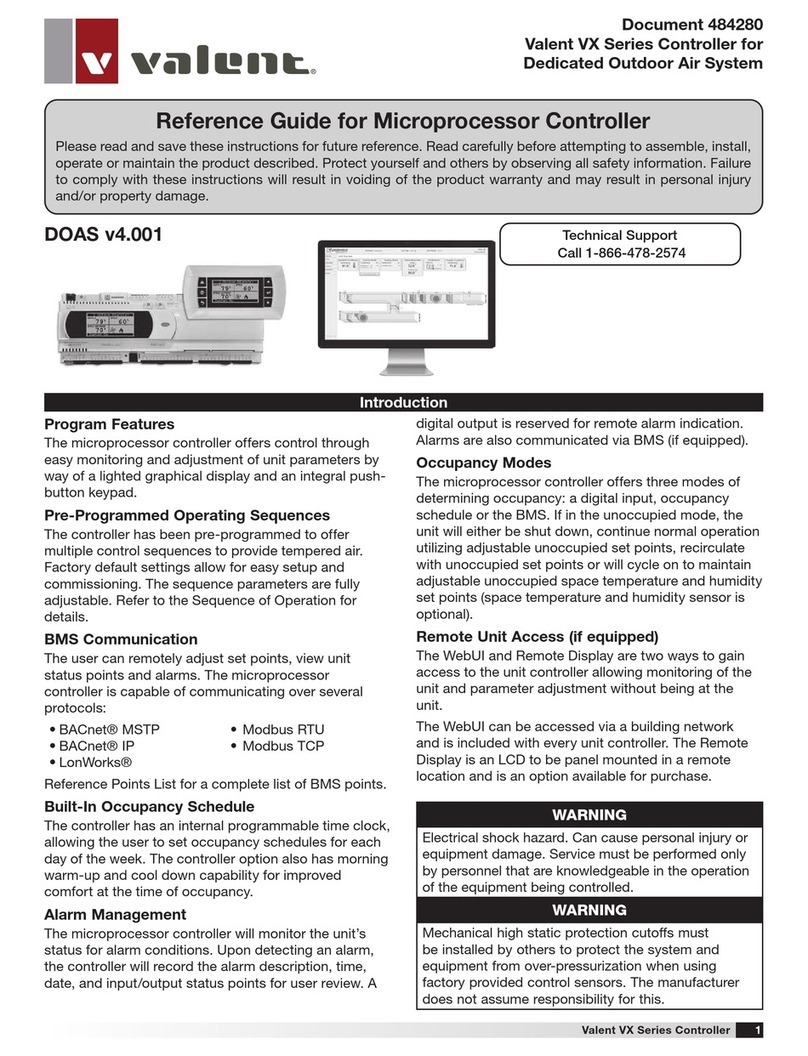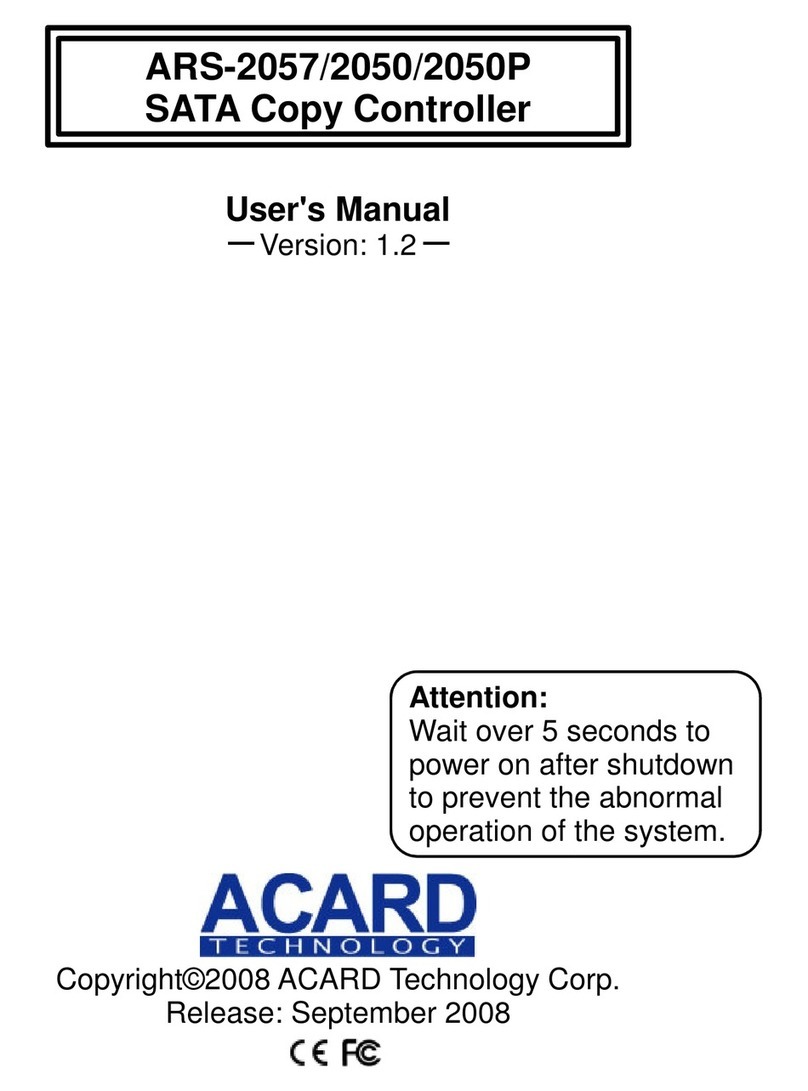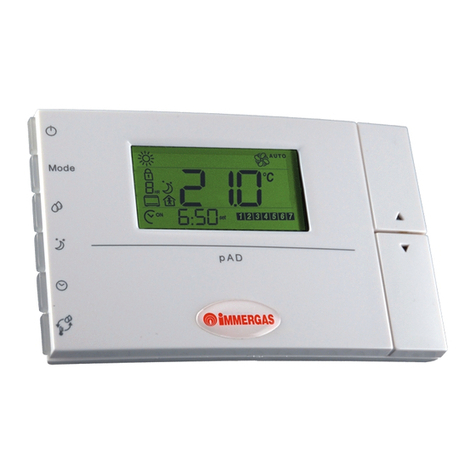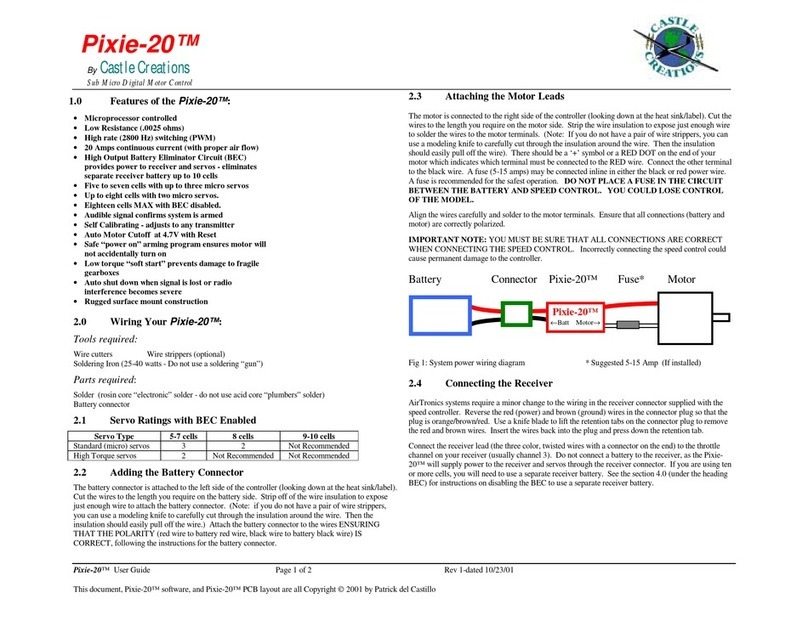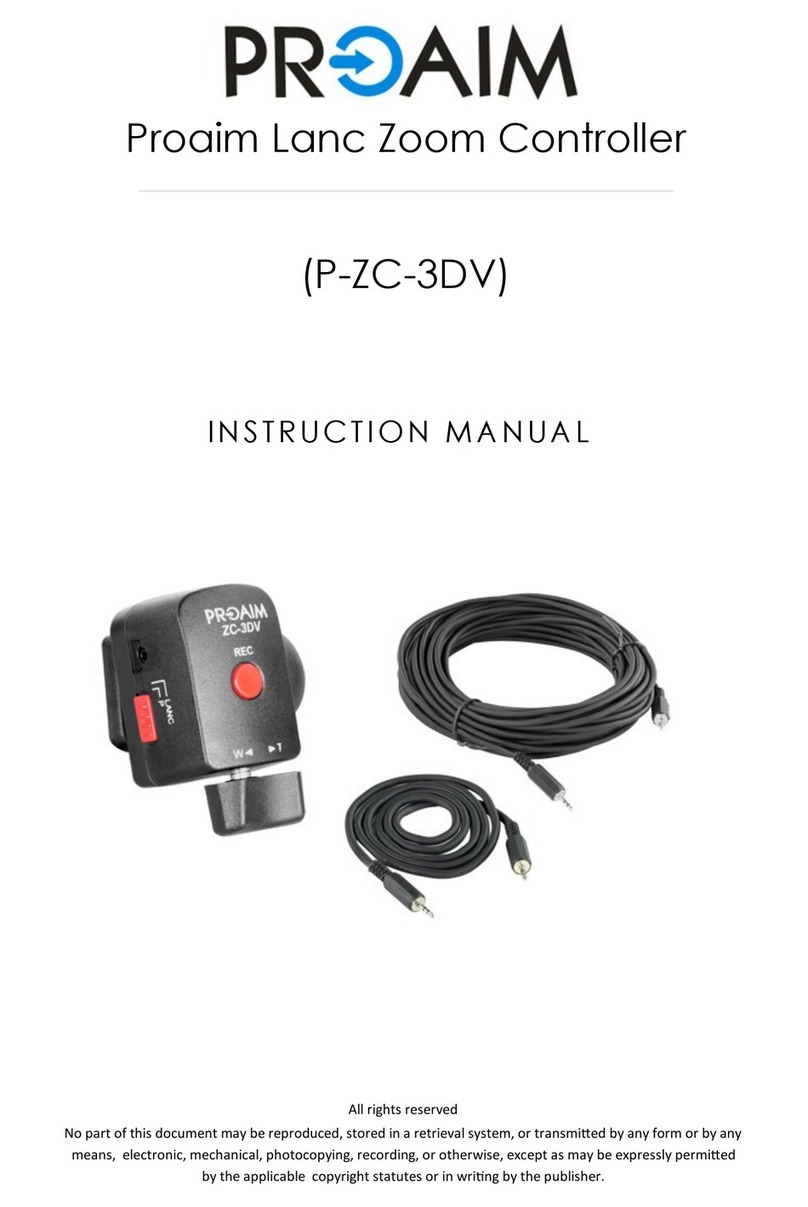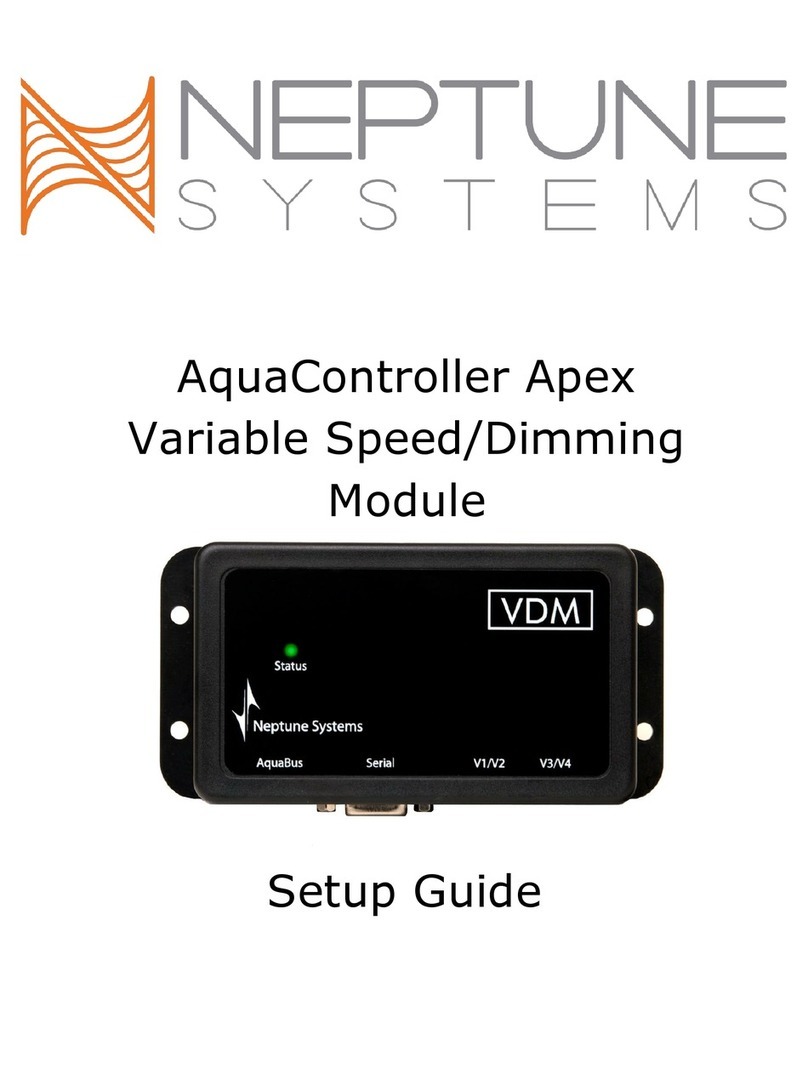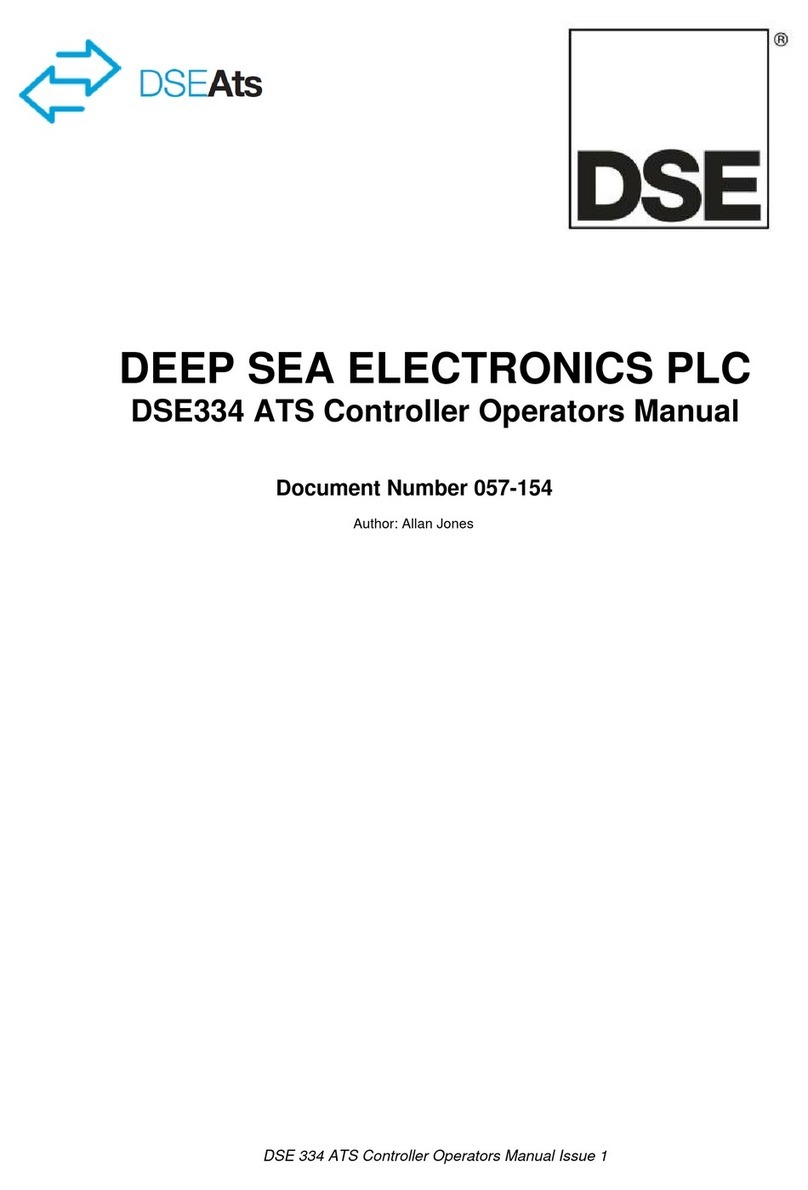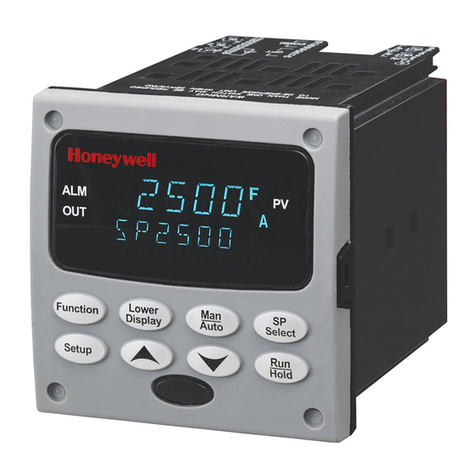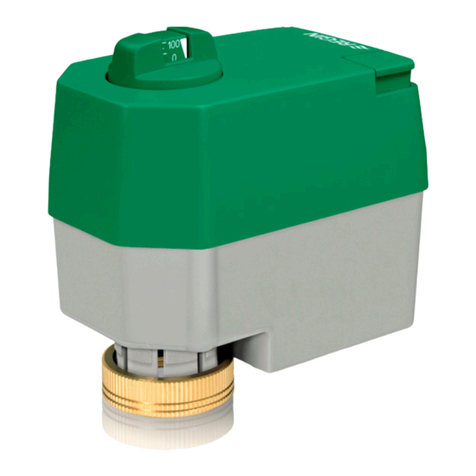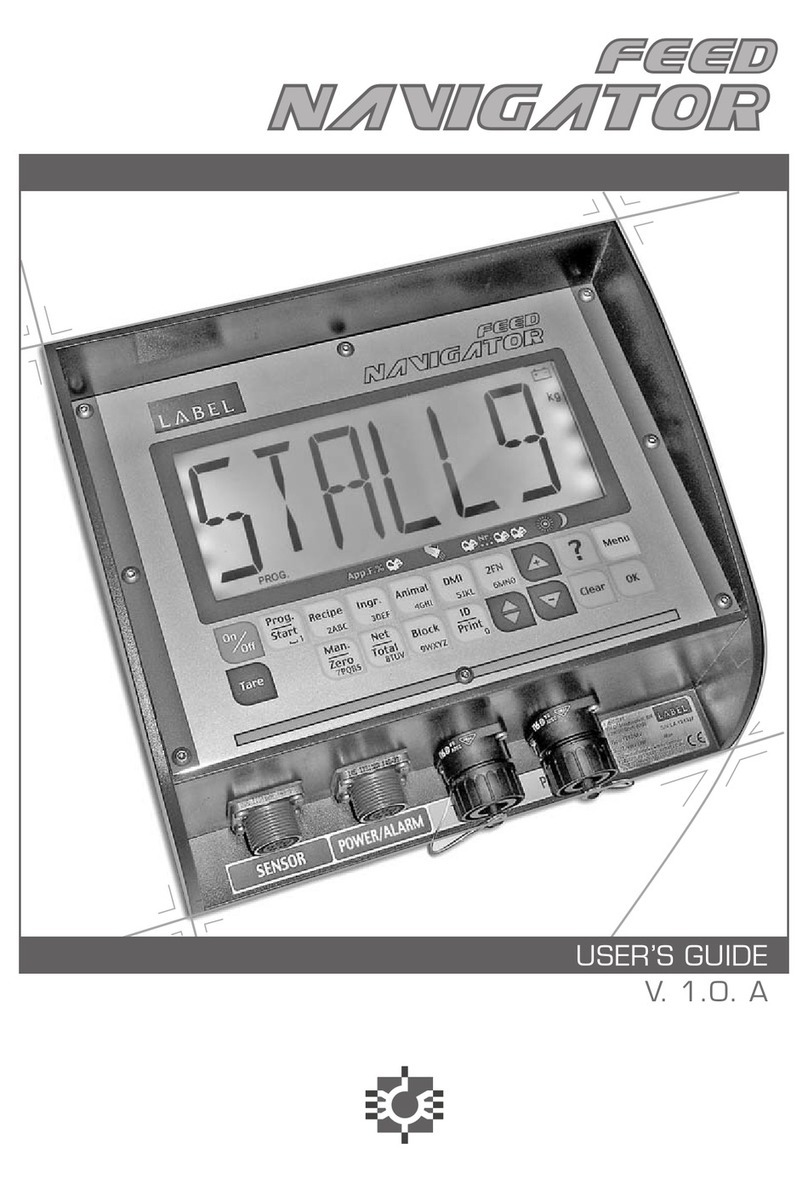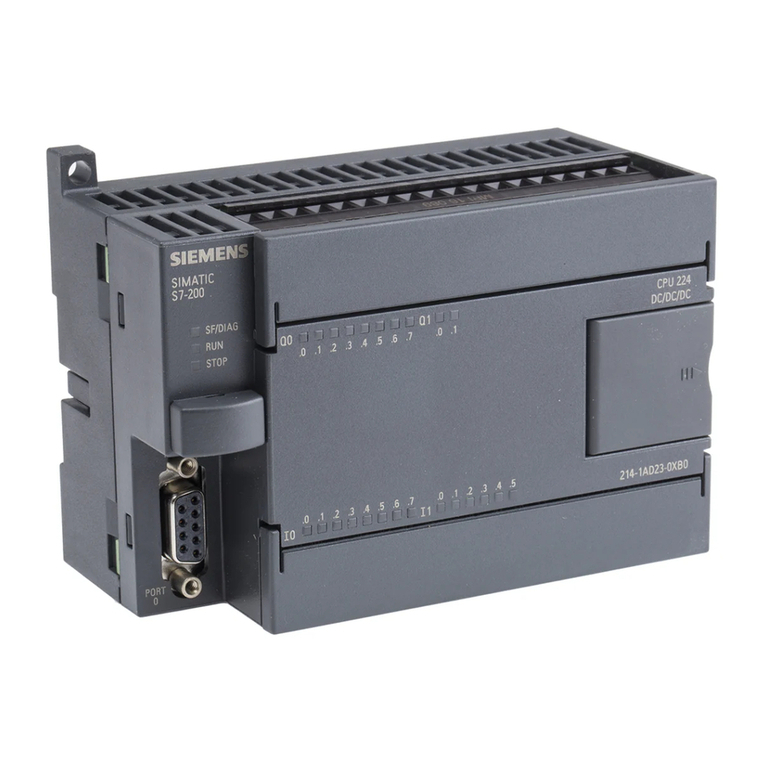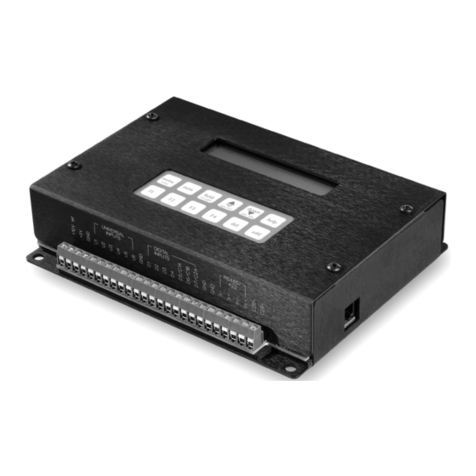Krom Schroder IC 50 Series User manual

DK S N P GR
➔www.docuthek.com
D GB F NL I E
TR CZ PL RUS H
© 2018 Elster GmbH · Edition 01.18
Safety
Please read and keep in a safe place
Please read through these instructions
carefully before installing or operating. Following the
installation, pass the instructions on to the opera-
tor. This unit must be installed and commissioned
in accordance with the regulations and standards
in force. These instructions can also be found at
www.docuthek.com.
Explanation of symbols
• , , , ... = Action
▷= Instruction
Liability
We will not be held liable for damage resulting from
non-observance of the instructions and non-com-
pliant use.
Safety instructions
Information that is relevant for safety is indicated in
the instructions as follows:
DANGER
Indicates potentially fatal situations.
WARNING
Indicates possible danger to life and limb.
CAUTION
Indicates possible material damage.
All interventions may only be carried out by qualified
gas technicians. Electrical interventions may only be
carried out by qualified electricians.
Conversion, spare parts
All technical changes are prohibited. Only use OEM
spare parts.
Changes to edition 0.6
The following chapters have been changed:
– Installation
– Wiring
– Commissioning
– Technical data
– Certification
Contents
Operating instructions
D
GB
F
NL
I
E
GB-1
0584
Translation from the German
Actuator IC 50
Actuator IC 50..........................
Contents ..............................
Safety.................................
Checking the usage .....................
Intended use ...........................2
Part designations ........................2
Installation ............................
Wiring ................................
IC 50 .................................4
IC 50..E ...............................5
Input signal ............................5
Commissioning.........................6
Manual mode facilitates setting .............6
IC 50..E, continuous control: adapting the
input signal to the adjustment angle..........6
Changing the direction of rotation .........7
Accessories ...........................7
Maintenance ...........................7
Assistance in the event of malfunction .....7
Technical data .........................8
Logistics ..............................9
Certification ...........................9
Declaration of conformity ..................9
Eurasian Customs Union ..................9
Contact ..............................0
Safety
Contents

GB-2
D
GB
F
NL
I
E
Checking the usage
Intended use
Actuator IC 50
It is designed for all applications that require precise,
controlled rotary movement between 0° and 90°. If
the voltage is disconnected, the actuator stops at
the current position.
The combination of actuator IC50 and butterfly valve
DKR is designed to adjust volumes of hot air and
flue gas on various appliances and flue gas lines.
This function is only guaranteed when used within the
specified limits– see page8 (Technical data). Any
other use is considered as non-compliant.
For information on butterfly valves DKR, see DKR
operating instructions→www.docuthek.com→
Kromschröder→Products→03Valves and but-
terfly valves.
Type code
Code Description
IC 50 Actuator for butterfly valves
-0
-07
-5
-0
-60
Running time [s]/Adjustment angle [°]:
3.7/90
7.5/90
15/90
30/90
60/90
W
Q
H
Mains voltage:
230 VAC, 50/60 Hz
120 VAC, 50/60 Hz
24 VAC, 50/60 Hz
7
5
0
0
Torque:
3 Nm
7 Nm
15 Nm
20 Nm
30 Nm
E
T
Continuous control
Three-point step control
R0 Feedback potentiometer
Combination of actuator with butterfly valve
Type IDR + attachment set
IDR..GD IDR + attachment set with linkage
(DKR..D)
IDR..GDW
IDR + attachment set with linkage
and heat deflector (DKR..D)
IDR..GA IDR + attachment set with linkage
(DKR..A)
IDR..GAW
IDR + attachment set with linkage
and heat deflector (DKR..A)
IDR..AU IDR + attachment set for axial mount-
ing (IC50 above the pipe)
IDR..AS IDR + attachment set for axial mount-
ing (IC50 to the side of the pipe)
Part designations
0°
ccw
30°
60° 90°
0°
30°
cw
60°
90°
5
4
7
8
1
2
3
6
Housing cover
Cover
Angle-of-rotation indicator
4Slide switch (S10/S12)
5Toggle switch (S11)
IC 50..E:
6min/max buttons
7DIP switch
8Red and blue LEDs
Mains voltage, electrical power rating, enclosure,
ambient temperature, torque and installation posi-
tion– see type label.
D-49018 Osnabrück, Germany
www.kromschroeder.com
IC
P:
U:
Installation
CAUTION
Please observe the following to ensure that the
actuator is not damaged:
– Do not store or install the unit in the open air.
– Dropping the device can cause permanent dam-
age. In this event, replace the entire device and
associated modules before use.
▷Installation in the vertical or horizontal position,
not upside down.
▷
For the assembly of actuator with butterfly valve
and attachment sets, and for installation in a pipe,
see DKR operating instructions.

GB-3
D
GB
F
NL
I
E
▷
Do not insulate the actuator with thermal insu-
lation.
Wiring
WARNING
Electric shocks can be fatal!
–Before working on possible live components,
ensure the unit is disconnected from the power
supply.
–It must be possible to isolate the actuator from
the power supply. Provide a double pole switch.
▷Use temperature-resistant cables (≥ 90°C).
▷Install supply and signal lines separately.
▷Cables should be installed well away from high-
voltage lines of other devices.
▷Observe EMC Directive for installation of signal
lines.
▷
Conductors which have not been connected
(spare conductors) must be insulated at their
ends.
▷Use cables with wire end ferrules.
▷Cable cross-section: max. 2.5mm².
▷
When operating two or more actuators in parallel,
the three-point step controller (terminals 1 and2)
must be electrically isolated to avoid leakage
currents. We recommend using relays.
▷Interference suppression capacitors installed in
the system must only be used in conjunction with
a series resistor so as not to exceed the maxi-
mum current– see page8 (Technical data).
▷Running times are reduced by a factor of 0.83
at 60 Hz compared to 50 Hz.
▷
External devices can be activated or intermediate
positions can be checked via three additional,
floating, infinitely adjustable switches (cams S1,
S2 andS5).
▷The input signals for the actuator can be set via
DIP switches. DIP switch positions that are not
indicated can be freely selected, see connection
diagram, page5 (IC 50..E).
Disconnect the system from the electrical power
supply.
Shut off the gas supply.
▷
Before opening the unit, the fitter should ground
himself.
0°
ccw
30°
60° 90°
0°
30°
60°
90°
2
3 4 5
3
4
6 Wire as shown on the connection diagram, see
IC50, page 4 (Three-point step control), or
IC50..E, page5 (Three-point step control),
page 5 (Two-point step control), page 5
(Continuous control).

GB-4
D
GB
F
NL
I
E
IC 50
L1 L1 L1 N
U+
UM
U-
7 Set switch S10 to Automatic mode.
▷Voltage is applied to terminals 3 and4.
Three-point step control
▷In the case of default setting “Closed”:
The butterfly valve opens when voltage is applied
to terminal2.
The butterfly valve closes when voltage is applied
to terminal1.
▷
Terminals 6 to 13 must be operated with the
same voltage potential.
Feedback
▷
A feedback potentiometer offers the option of
monitoring the current position of the actuator.
▷The potentiometer must be utilized as a voltage
divider. The change in position of the potentiom-
eter wiper (which corresponds to the actuator
position) can be measured as a changing voltage
between U-and UM.
▷
Other circuit layouts produce measurement
results that are inaccurate and do not remain
stable over a long period of time or are non-
reproducible. They also reduce the service life
of the feedback potentiometer.
▷The available range depends on the adjustment
of switching cams S3 andS4.
100 %
90°0°
50 %

GB-5
D
GB
F
NL
I
E
IC 50..E
1211 13
1116
Choosing the input signal
Load impedance of the
current input
Behaviour in the event
of cable discontinuity
(4–20mA):
Two-point step control
Changing the direction of
rotation
cw = clockwise,
ccw = anti-clockwise.
Valve moves to CLOSED
position
Valve moves to OPEN
position
Actuator stops
7 Set switch S10 to Automatic mode.
▷Voltage is applied to terminals 3 and4.
Three-point step control
▷
No voltage at terminal 5: three-point step control.
▷
Voltage must be applied to terminals 3 and4
continuously.
▷
The low-fire rate (CLOSED) and the high-fire rate
(OPEN) are controlled via terminals 1 and2.
Two-point step control
8 Connect bridge between terminals 1 and3.
9 Set the DIP switches to 2-point step control.
▷
When voltage is applied to terminal5, the actua-
tor opens. When no voltage is applied to termi-
nal5, the actuator closes.
▷Terminals 17 and 18 for continuous control are
not required in the case of 2-point control.
Continuous control
▷Voltage at terminal 5: continuous control.
▷The actuator reacts to the setpoint specification
(0(4)–20mA, 0–10V) via terminals 17 and18.
▷
The continuous signal corresponds to the ad-
justment angle to be approached (e.g. with a 0
to 20mA signal, 10mA correspond to a valve
angle of45°).
Feedback
▷Terminals 19 and 20: the IC 50..E offers the op-
tion of monitoring the current position of the ac-
tuator via the continuous 4–20mA output signal.
Input signal
▷The positioning control hysteresis can be adjust-
ed on a potentiometer to suppress fluctuations
or interference in the input signal.
▷The hysteresis can be increased accordingly by
turning the potentiometer clockwise.

GB-6
D
GB
F
NL
I
E
Commissioning
▷
The maximum opening angle of the valve can be
set using switching camS3 and the minimum
opening angle can be set usingS4.
▷
Switching cams S1/S2/S5 can be optionally
adjusted.
WARNING
Risk of electric shock due to live components and
cables.
Manual mode facilitates setting
▷
The positions in the low-fire rate range can be
precisely adjusted.
Set slide switch S10 to Manual mode. The blue
LED lights up.
Voltage must be continuously applied to the ac-
tuator to allow the valve to open.
Press the toggle switch S11 upwards.
▷The valve opens.
4 Press the toggle switch S11 downwards.
▷The valve closes.
CAUTION
Please observe the following to ensure that the
actuator is not damaged:
–
The function of switching cams S3/S4 changes
if the direction of rotation ccw/cw (anti-clock-
wise/clockwise) is modified.
ccw (factory setting):
S3 = maximum angle, S4 = minimum angle.
cw:
S3 = minimum angle, S4 = maximum angle.
▷The factory setting ccw is described here.
Setting the maximum opening angle using
switching camS(ccw)
▷Only adjust S3 between 40° and 90°.
▷Feedback signal to terminal 15.
▷
S3 can only be accessed when the valve is in
an open position.
Move the actuator to its maximum opening angle.
0°
ccw
30°
60° 90°
0°
30°
60°
90°
2
3 4 5
3
4
Adjust the trip point of camS3 using a screw-
driver.
▷ccw:
Anti-clockwise = smaller opening angle.
Clockwise = greater opening angle.
cw:
Anti-clockwise = greater opening angle.
Clockwise = smaller opening angle.
S1
S2
S3
S4
S5
CAUTION
Remove the screwdriver again before attempting
to actuate the switching cams.
Setting the minimum opening angle using
switching camS4(ccw)
▷Only adjust S4 between 0° and 30°.
▷Feedback signal to terminal 16.
4 Move the actuator to its minimum opening angle.
5 Adjust the trip point of camS4 using a screw-
driver.
Adjusting switching cams S/S/S5
6 Adjust the trip point of cams S1/S2/S5 using a
screwdriver.
▷The cams can be adjusted over the full angle of
rotation (0–90°) of the actuator.
IC 50..E, continuous control: adapting the
input signal to the adjustment angle
▷Maximum input signal =
^
maximum angle.
Minimum input signal =
^
minimum angle.
▷
The IC 50..E is in Manual mode and the blue
LED is lit.
Automatic calibration
▷The minimum and maximum opening angle cor-
responds to the setting of switching cams S3
andS4 in the case of automatic calibration.
Press the min and max buttons simultaneously
(approx. 3seconds) until the red(R) and blue(B)
LEDs flash.
▷
Calibration is completed when the blue LED is lit
continuously and the red LED goes out.

GB-7
D
GB
F
NL
I
E
Manual calibration
▷The minimum and maximum opening angle can
be anywhere within the range set using switching
cams S3 andS4.
Move the valve to the required min. position by
pressing toggle switchS11.
Press the min button (approx. 3seconds) until the
blue LED goes out briefly (approx. 0.5seconds).
Move the valve to the required max. position by
pressing toggle switchS11.
4 Press the max button (approx. 3seconds) until
the blue LED goes out briefly (approx. 0.5sec-
onds).
Characteristic curve inversion
▷The mA value for low fire has to be greater than
the mA value for high fire.
Press the min or max button until the red LED
lights up briefly (approx. 0.5 seconds) and hold
it in for approx. 3 seconds more until the blue
LED goes out briefly (approx. 0.5 seconds).
Changing the direction of rotation
IC 50
▷
The direction of rotation is defined using slide
switchS12.
▷
cw (blue mark on the cover) = valve opens
clockwise,
ccw (white mark) = valve opens anti-clockwise.
IC 50..E
▷
The direction of rotation is defined using DIP
switch7 and slide switchS12.
IC 50, IC 50..E
▷When changing the direction of rotation, these
two switches must be set to the same position:
cw (blue mark on the cover) and ccw (whitemark).
▷
The function of switching cams S3/S4 changes
if the direction of rotation (ccw/cw) is modified,
see page6 (Commissioning).
Accessories
Wall mounting bracket
The wall mounting bracket is required if the actuator
is to be attached to a wall.
OrderNo.: 74924791
10
93
113
7
124
1 2
▷
Attachment sets for mounting to butterfly
valveDKR, see Butterfly valve DKR operating
instructions.
Maintenance
Actuators IC 50 suffer little wear and require little ser-
vicing. We recommend a function check once a year.
Assistance in the event of
malfunction
WARNING
To avoid harm to persons and damage to the unit,
please observe the following:
– Electric shocks can be fatal! Before working
on possible live components, ensure the unit
is disconnected from the power supply.
– Never remove the circuit board!
– Unauthorized repairs or incorrect electrical con-
nections may cause the butterfly valve to open
resulting in defects.
? Fault
! Cause
• Remedy
? The valve disc does not move.
! The actuator is in Manual mode (IC50..E: blue
LED is lit).
• Set slide switch S10 to Automatic mode.
! No voltage at terminal 5.
• Check voltage at terminal 5.
! Motor coil or electronics defective as a result of
excessive ambient temperature and/or excessive
operating voltage.
• Check ambient temperature and/or operating
voltage, see type label or page8 (Technical
data).
! Cam trip points maladjusted. S4 has been set to
a wider angle than S3 (IC50..E: red LED lights
up, blue LED flashes 1×, if the unit has been
automatically calibrated).
• Adjust the trip points, see page6 (Commis-
sioning). Then calibrate the IC50..E.
! Electrical fault!

GB-8
D
GB
F
NL
I
E
• Remember the minimum distance from ignition
cables.
IC 50..E
! DIP switch position is incorrect.
• Set correct input signal using the DIP switches.
! The adjustment range has been set too small dur-
ing manual calibration. The red LED flashes3×.
• Increase adjustment range using min and max
buttons, see page6 (Commissioning).
! The input signal on the 4–20mA setpoint input
is <3mA. The red LED flashes1×.
• Check input signal, remedy cable discontinuity.
? Valve disc moves constantly.
! IC 50..E: current signal fluctuates. The red LED
flashes2×.
• Check control loop, if possible attenuate it.
• Increase the hysteresis using the potentiometer,
see page5 (Input signal).
! IC 50: 3-point step signal fluctuates.
• Check/Adjust the 3-point step controller.
? Is it not possible for the fault to be eliminated
with the measures described above?
! IC 50..E: internal error. The red LED lights up,
the blue LED flashes2×.
• Remove the unit and return it to the manufacturer
for inspection.
Technical data
Mains voltage:
24VAC, -15/+10%, 50/60 Hz,
120VAC, -15/+10%, 50/60 Hz,
230VAC, -15/+10%, 50/60 Hz.
Type Running time [s/90°] Torque [Nm]
50 Hz 60 Hz 50 Hz/60 Hz
IC 50-03 3.7 3.1 3
IC 50-07 7.5 6.25 7
IC 50-15 15 12.5 15
IC 50-30 30 25 20
IC 50-60 60 50 30
Screw terminals for cables up to 2.5 mm2.
Angle of rotation: 0 – 90°, adjustable.
Holding torque = torque.
Contact rating of the cam switches:
Voltage Min. current
(resistive load)
Max. current
(resistive load)
24 – 230 V,
50/60 Hz 1 mA 2 A
24 VDC 1 mA 100 mA
Typical designed lifetime of the cam switches:
Switching
current
Switching cycles
cos φ= 1 cos φ= 0.3
1 mA 1,000,000 –
22 mA1) –1,000,000
100 mA 1,000,000 –
2 A 100,000 –
1) Typical contactor application (230V, 50/60Hz,
22mA, cosφ=0.3)
Enclosure: IP 65.
Safety class: I.
Duty cycle: 100%.
Electrical connection:
Line entrance: 3 x M20 plastic cable glands.
Ambient temperature:
-20 to +60°C, no condensation permitted.
Storage temperature: -20 to +40°C.
Three-point step signal to terminals 1 and 2:
minimum pulse duration: 100 ms,
minimum pause between 2pulses: 100 ms.
IC 50
Power consumption:
16 VA at 60 Hz, 13 VA at 50 Hz.
Resistance of the feedback potentiometer: 1kΩ,
max. 1 W, max. wiper current: 0.1 A.

GB-9
D
GB
F
NL
I
E
IC 50..E
Power consumption: terminals 1, 2 and 5: 16VA
at 60Hz, 13 VA at 50Hz,
terminal 3: 19 VA at 60Hz, 16 VA at 50Hz,
in total not exceeding: 19 VA at 60 Hz, 16 VA at
50Hz.
Feedback output: electrically isolated, max.500Ω
load impedance.
The output is always active when mains voltage is
applied to terminal3.
Input: electrically isolated,
4 (0) – 20mA: load impedance switchable be-
tween 50Ω and 250Ω,
0 – 10V: 100 kΩ input resistance.
Logistics
Transport
Protect the unit from external forces (blows, shocks,
vibration). On receipt of the product, check that the
delivery is complete, see page 2 (Part designa-
tions). Report any transport damage immediately.
Storage
Store the product in a dry and clean place.
Storage temperature: see page8 (Technical data).
Storage time: 6months in the original packaging
before using for the first time. If stored for longer
than this, the overall service life will be reduced by
the corresponding amount of extra storage time.
Packaging
The packaging material is to be disposed of in ac-
cordance with local regulations.
Disposal
Components are to be disposed of separately in
accordance with local regulations.
Certification
Declaration of conformity
We, the manufacturer, hereby declare that the prod-
uct IC50 complies with the essential requirements
of the listed Directives and Standards.
Directives:
– 2014/35/EU
– 2014/30/EU
Standards:
– EN 60730:2011
The production is subject to the stated Quality System
pursuant to DINENISO9001.
Elster GmbH
Scan of the Declaration of conformity (D,GB)– see
www.docuthek.com
Eurasian Customs Union
The product IC50 meets the technical specifications
of the Eurasian Customs Union.

GB-10
D
GB
F
NL
I
E
Contact
If you have any technical questions, please contact
your local branch office/agent. The addresses are
available on the Internet or from ElsterGmbH.
We reserve the right to make technical modifications
in the interests of progress.
Elster GmbH
Strotheweg 1, D-49504 Lotte (Büren)
Tel. +49 541 1214-0
Fax +49 541 1214-370
[email protected], www.kromschroeder.com
Contact
This manual suits for next models
5
Table of contents
Other Krom Schroder Controllers manuals
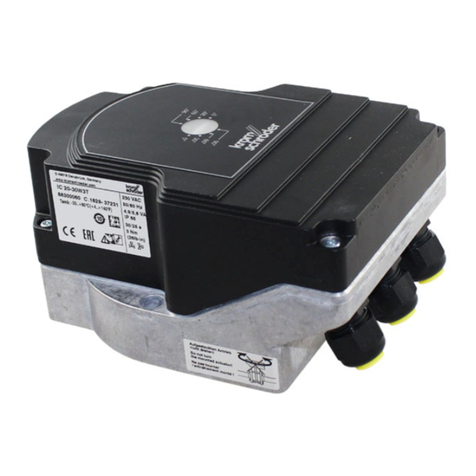
Krom Schroder
Krom Schroder IC 20 User manual
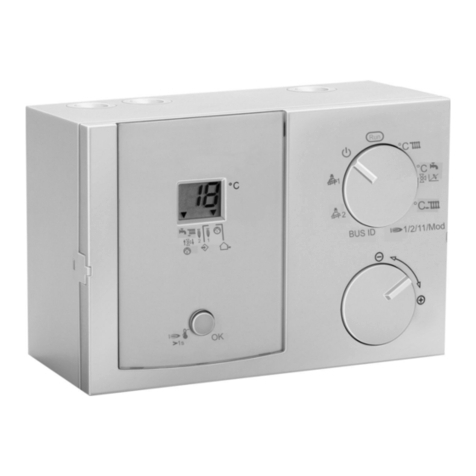
Krom Schroder
Krom Schroder Lago Basic 0201 R V1 User manual
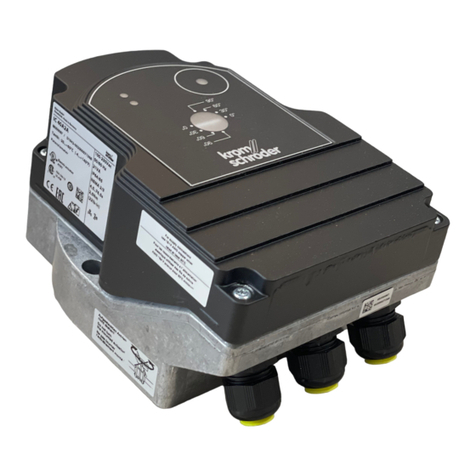
Krom Schroder
Krom Schroder IC 40 User manual

Krom Schroder
Krom Schroder IC 20 User manual

Krom Schroder
Krom Schroder IC 50 User manual
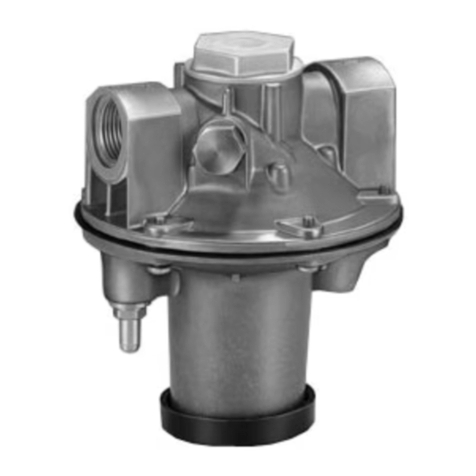
Krom Schroder
Krom Schroder GIK Series Manual
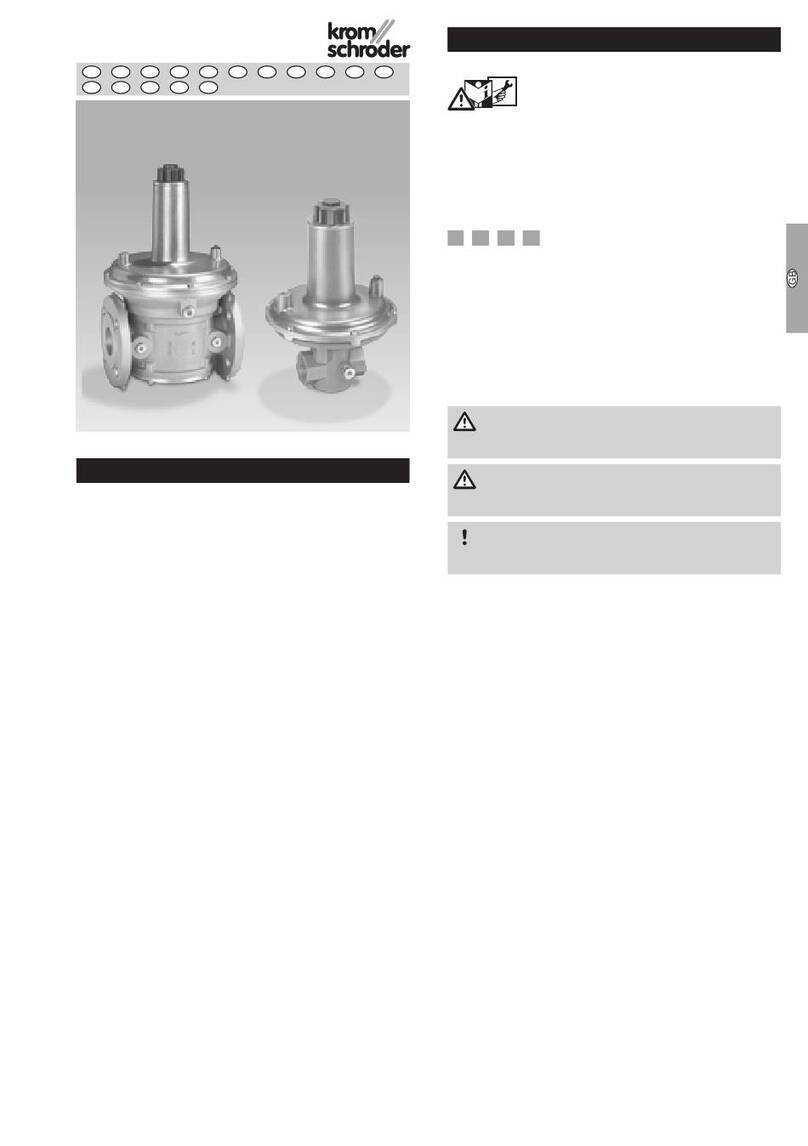
Krom Schroder
Krom Schroder VGBF 15R User manual

Krom Schroder
Krom Schroder IC 20 User manual
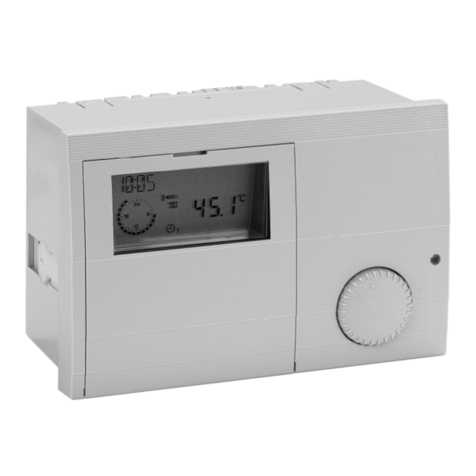
Krom Schroder
Krom Schroder E8.5064 V1 User manual

Krom Schroder
Krom Schroder GDJ 15 User manual

